
Next month, Arlington Public Schools is set to roll out a new, electronic campus management platform at a number of middle and high schools.
The goal is to improve building security and provide better oversight of students as they come and go from classrooms.
Kenmore, Dorothy Hamm, Gunston and Thomas Jefferson middle schools, as well as Wakefield, Washington-Liberty and Yorktown high schools, will adopt the app and web-based platform Minga, says APS spokesman Frank Bellavia.
The platform provides hall passes and monitors students coming in and going out of buildings to ensure that only students are in the school, Bellavia said. Schools can limit the number of students in the halls at one time and limit the number of passes per student, per day.
This comes as APS has separately upped its budget for safety and security measures, including school safety coordinators, security cameras and other technological upgrades pertaining to safety. That comes amid reports of student drug use, for which some teachers say skipping class is partly to blame, and nearly a dozen juvenile overdoses in Arlington this year.
Students can download Minga to their smartphone or use it on their laptop or tablet. The platform issues digital IDs with scannable barcodes and digital passes, which would replace physical ID cards and paper passes.
Wakefield High School Principal Peter Balas imported Minga this year from his days leading Alexandria City High School, which has had issues around violence inside and outside of the school.
“I see it as a tool to help me get better safety and security and to help things run more safely and smoothly,” he said. “My experience is that it has been… well-accepted by staff.”
Kenmore piloted an e-pass system last year and, when Balas arrived in Arlington, principals were discussing whether to adopt such a system. That is when he suggested Minga.
Minga notifies teachers of students who are out of class and can ensure certain students are not in the hallways at the same time — if they tend to break school rules when together. It tracks trends over time, such as overall time spent out of class and passes issued or students who spent the most time not in class and where they went.
Balas would like to see students scan their IDs to enter school buildings, too, so staff know who is in the building before they take attendance. He said it also can help staff track down and follow-up with students who arrive at school but ditch class or leave mid-day.
“[But] for me, one of the most important things, from safety standpoint, is that it basically would prevent anyone who doesn’t go to school from trying to get in,” Balas said.
Earlier this year, Wakefield was placed in lockdown after reports of a trespasser, possibly armed with a gun, and a threat against a student.
“Almost every period, we have comings and goings in the school,” he continued. “It will also help us keep track of all that movement and make sure access is secure and legitimate.”
When asked how this might interfere with building-level “Away for the Day” policies — in which phones are required to be off and stored during school hours — Bellavia said students can request passes from their tablets or laptops.
Balas says he does not think this will interfere with Wakefield’s mobile phone policy.
Administrators and security staff are in the first wave of training on the new system and teachers will soon follow.
“I was purposeful not wanting to inundate [teachers] when we aren’t ready to launch yet,” Balas said. “I’m hoping in the next month or so to have it fully up and running but it is something where I have to take the temperature of everyone and make sure it doesn’t overwhelm people.”
Minga will cost around $50,000 to roll out, Bellavia said.
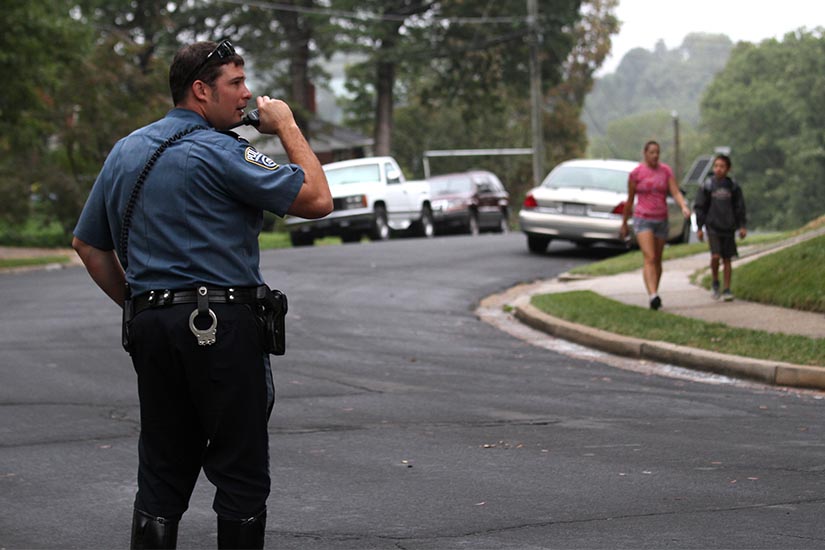
Arlington County police will be stepping up enforcement and a traffic safety education next week as students go back to school.
The first day of school for Arlington Public Schools is Monday, meaning more children walking, bicycling, and riding the bus around Arlington.
With back-to-school time around the corner, the police department is reminding people to follow the rules of the road. A new press release urges drivers to watch for students, follow posted speed limits — which have been lowered to 20 mph around several schools — and to put down their phones.
“Transportation safety is a shared responsibility and it is up to all of us to keep our students safe by following the rules of the road,” the release said. “ACPD will conduct a high-visibility transportation safety campaign in and around school zones and bus stops to ensure the trip to class is as safe as possible.”
The campaign will include enforcement as well as variable message boards with safety messages.
“With a little awareness and prevention, all travelers can arrive at their destinations in a timely and safe manner,” said ACPD.
The release also notes some new initiatives, including “Walking School Buses” with dedicated volunteers and adding more speed humps near schools.
“Reducing vehicle speeds is fundamental to reducing severe crashes, and speed humps are a useful tool for decreasing speeds on neighborhood roads,” the press release says. “Arlington has not added new speed humps in the last decade. The County plans to reintroduce speed humps through a limited pilot focused on reducing speeds in school slow zones where the introduction of 20 mph speed limits has not resulted in lower speeds.”
“The pilot will begin at three sites: S. Lang Street near Gunston Middle School, S. Queen Street near Hoffman Boston Elementary, and 19th Street N. near Cardinal Elementary,” the release continues. “The pilot will assess speeds and operations before and after the introduction of the tactical speed humps, as well as community input. Additional speed hump sites may be considered in additional school zones following the initial installations.”
More, below, from ACPD.
With students returning to the classroom on Monday, Aug. 28, 2023, there will soon be an increase in children walking, bicycling, and riding the bus to schools throughout Arlington. Transportation safety is a shared responsibility and it is up to all of us to keep our students safe by following the rules of the road. The Arlington County Police Department (ACPD) will conduct a high-visibility transportation safety campaign in and around school zones and bus stops to ensure the trip to class is as safe as possible.
Variable message boards will be placed along roadways in Arlington to raise awareness about the start of the school year and to share important safety messaging. With a little awareness and prevention, all travelers can arrive at their destinations in a timely and safe manner.
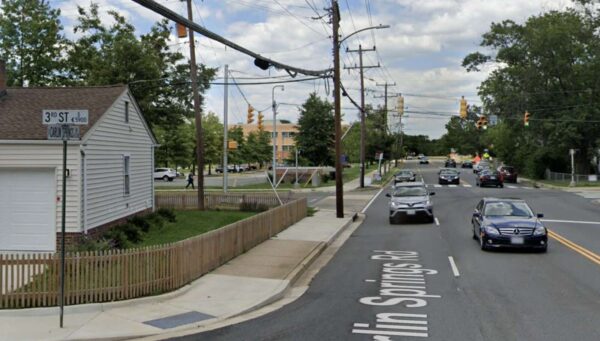
After a driver collided with a child on a bicycle on S. Carlin Springs Road this week, neighbors and advocates are calling for street safety upgrades.
For its part, Arlington County says it has already been working on safety measures for the area, which has narrow sidewalks, little or no pedestrian buffer and a history of crashes. Upcoming steps include reducing speeds near the schools in the area: Kenmore Middle School and Carlin Springs Elementary.
“We are looking into the details from police regarding the crash and will identify next steps based on the report,” Dept. of Environmental Services spokeswoman Katie O’Brien said.
And Arlington County Board member Matt de Ferranti has recently gotten involved, too. He tells ARLnow he has walked the area with advocates and will be meeting with staff next week.
“First and foremost, I understand that the young man is okay and the safety of our kids and our residents is highest on my mind,” de Ferranti said. “Second, the accident raises important and urgent questions about safety in that whole corridor… We need to do better to address them.”
How the crash happened
Just before 7 p.m. on Monday, a driver traveling south on S. Carlin Springs Road proceeded through a green light and struck a juvenile riding a bicycle in the crosswalk, Arlington County Police Department spokeswoman Ashley Savage said.
The driver remained on scene. The child, who did not require a trip to the hospital for treatment, was tended to on scene by medics, Savage said. No citations were issued.
While ACPD does not provide identifying information, she did say the child involved was older than first reported on social media.
The boy was bleeding, but injuries appeared NLT. He was tended to by medics and police in the back of what appeared to be an @APSVirginia white van (logo on pass door – assuming Kenmore M.S. related) to in the 7-11 parking lot. pic.twitter.com/qtr4Yijzrn
— Matthew Young (@matthewyoung31) October 3, 2022
A history of unsafe sidewalks
Community advocate Janeth Valenzuela tells ARLnow that she passed by the crash around 6:45 p.m. and saw emergency responders. She says she’s been working on safety along S. Carlin Springs Road for many years now, and has suggested everything from building a bridge for kids crossing the road to erecting a fence to prevent kids from getting pushed into the street.
“I’ve been proposing a lot of things, but they don’t take it into consideration,” she said. “The solution is hard.”
S. Carlin Springs Road is an important walking route for Kenmore students, but she and other residents say the pedestrian amenities are poor. Sidewalks are narrow and not well maintained and often do not have any landscaping separating pedestrians from traffic.
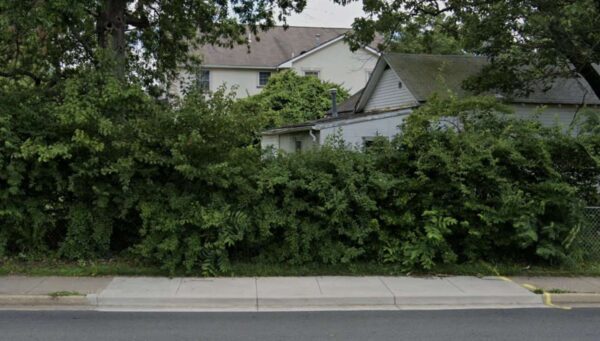
And people have been telling the county the same thing for nearly a decade, according to a 2014 report by the APS Multimodal Transportation and Student Safety Committee and Advisory Committee on Transportation Choices meeting minutes from 2017.
During one ACTC meeting in 2017, a father said moms with strollers pass kids playfully shoving each other on the sidewalk as cars whiz right next to them. In the winter, if the sidewalks aren’t plowed, kids walk in the road, he added.
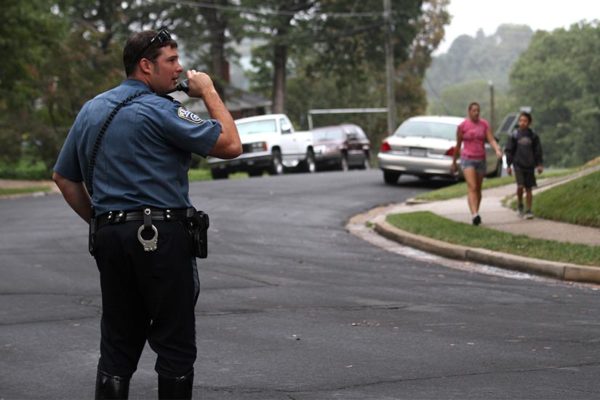
Signs and stepped-up enforcement are part of the police plan for bringing Arlington students back to the classrooms safely.
In advance of the first day of school for Arlington Public Schools students on Monday, the Arlington County Police Department is encouraging drivers to be especially cautious on local roads.
“On Monday, August 29, 2022, there will soon be an increase in children walking, bicycling, and riding the bus to schools throughout Arlington,” ACPD said in a press release this week. “Transportation safety is a shared responsibility and it’s up to all of us to keep our students safe by following the rules of the road.”
The police department says it will “conduct a high-visibility transportation safety campaign in and around school zones and bus stops to ensure the trip to class is as safe as possible.” That includes enforcement and electronic signs “placed along roadways in Arlington to raise awareness about the start of the school year and to share important safety messaging.”
Police noted that last fall the Arlington County Board voted to establish 13 “School Slow Zones” around public and private schools in the county. The zones reduce the speed limit to 20 mph on roads within 600 feet of the school.
The department also reminded drivers that the law requires drivers to stop behind a school bus that is loading or unloading passengers, except when traveling in the opposite direction on a divided highway.
An ACPD press release with safety and traffic law reminders, along with a new “Back to School Safety PSA” video starring APS Superintendent Dr. Francisco Durán and Arlington police chief Andy Penn video, are below.

Four people died in crashes in Arlington during 2021, the first year of the county’s initiative to eliminate traffic fatalities and injuries.
That’s in addition to 61 severe crashes, according to the first annual report evaluating the transportation safety initiative Vision Zero.
Arlington County is measuring the effectiveness of its five-year action plan by tracking the severity of crashes and factors involved, such as speed, alcohol and whether a pedestrian or bicyclist were injured.
This month marks the kickoff of the initiative’s second year, which will feature awareness campaigns around behaviors that lead to serious crashes. The campaign will run through December and concentrate on different behaviors each month, starting with bike awareness.
The overall number of crashes in 2021 — 1,785 — decreased by about 30% compared to previous years, but that was attributable to lower traffic levels compared to pre-pandemic years, according to the report.
All four fatal crashes occurred at intersections, and did not involve a pedestrian or bicyclist. In 2020, there were four fatal crashes and 50 that caused severe injury, according to the county’s crash analysis dashboard.
The report noted the 174 alcohol-related and 487 speed-related crashes in 2021 marked a slight uptick. Speed was a factor in one of the fatal crashes.
Lessons learned
Many of the more than 90 action items the county lists in the framework have been checked off. Arlington has completed or started 36 small-scale safety projects, finished an analysis of 69 crash hot spots, and facilitated 55 transportation safety classes and events, among other tasks.
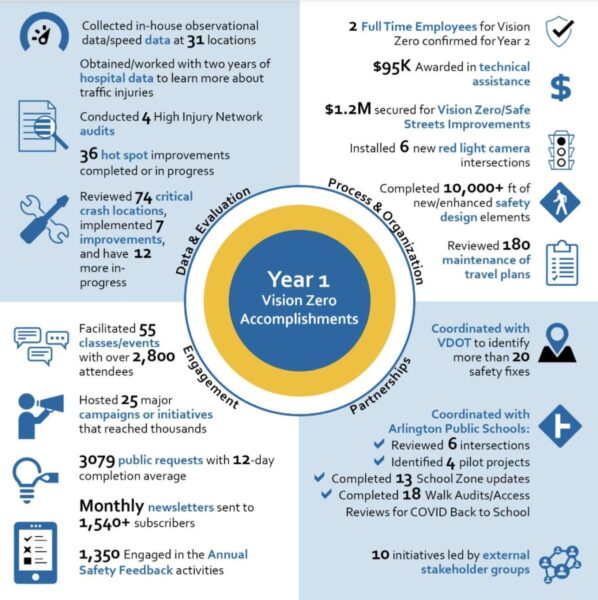
Some of the lessons learned in year one include a need to amp up community engagement, and decrease the frequency of crash hot spot analyses from once a year to every two years.
Two walkability routes that were piloted saw opposite outcomes. A pilot on Lorcom Lane in residential North Arlington was extended and county staff are looking to fund a permanent sidewalk there in the upcoming Capital Improvement Plan.
The report noted the Lorcom Lane path “showed high usage, positive community feedback, and observed benefits from separating cars, bikes, and pedestrians.”
But the county halted a similar effort — temporary bollards and wheel stops on S. Carlin Springs Road — months after placement. Arlington Public Schools, Arlington police and community members raised concerns with the pilot after observing “erratic driving around the barriers.”
That area of S. Carlin Springs Road has narrow sidewalks, little or no pedestrian buffer and a history of crashes. The goal of the pilot was to create a safer walking path for students at Campbell Elementary School, Carlin Springs Elementary School and Kenmore Middle School.
County staff will continue to assess options for “enhancing sidewalks and access along the corridor, including connectivity options when the County redevelops the Virginia Hospital Center site,” according to the report.
Several other efforts to increase safety, particularly around schools, advanced in the first year of Vision Zero. The installation of 20 mph school slow zones around 13 schools in early 2022 is under evaluation and could be extended to all schools in the county.
In January, the County Board approved speed cameras in school and work zones, heralding them as a step toward the Vision Zero goal.
In the upcoming year, the report says, there are two full-time employees confirmed to work on Vision Zero and some studies will be completed, such as the evaluation of roadways that have speed limits above 30 mph.
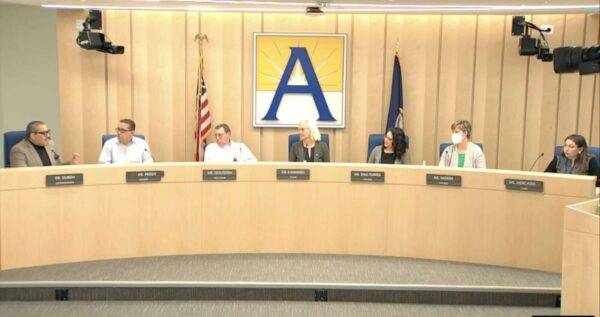
Arlington Public Schools is adding funding to its proposed budget to fund positions supporting student mental health and safety.
The revised budget includes about $800,000 to add the equivalent of 5.5 full-time school safety coordinators and restore four psychologist and social worker positions, which were initially cut due to lower enrollment projections.
“I’m really glad to see our budget is paying attention to mental health, which we know is a significant concern locally and nationally,” School Board member Mary Kadera said during the School Board meeting Thursday night.
Members of the School Board unanimously approved several changes to the proposed budget for the 2022-23 fiscal year, but the budget is not yet set in stone — final approvals are slated for May.
The additional safety and mental health expenses come as many schools — particularly the middle schools — are seeing an uptick in fights and instances of students either bringing, or threatening to bring, weapons to school, as ARLnow previously reported. School administrators say they are stepping up their focus on social-emotional learning in response.
Last week week, Arlington police investigated text messages referencing potential violence at Swanson and Dorothy Hamm middle schools, but concluded there was no active or ongoing threat, Arlington County Police Department spokeswoman Ashley Savage said. The week before last, a Swanson student brought a taser to school, according to an email to families.
Additionally, in response to students filming peers in the restroom, teachers have started monitoring bathrooms and confiscating students’ phones during bathroom breaks, Fox 5 reported.
Responding to concerns from Swanson staff and parents, administrators said in a School Talk email, provided to ARLnow, that there will be increased monitoring, more mental health and social-emotional learning and improved communication with families and staff when incidents arise.
This year, APS has leaned on specialized school safety staff after removing sworn ACPD School Resource Officers from its buildings last summer.
None of the newly budgeted “school safety coordinators” will go to Swanson, but they will go to Gunston Middle School, the Langston High School Continuation Program and New Directions programs, and the newly renovated education center building that will serve Washington-Liberty High School. There will also be two substitutes.
The coordinators add to an existing 28.5 full-time-equivalent school safety staff members, who once were called “security resource assistants.” APS aims to have at least one coordinator per middle and high school building, with an additional coordinator per 500 students beyond that. Roaming coordinators support multiple elementary schools.
These staff monitor hallways, watch for student behavior during arrival and dismissal and during night time events and activities, ensure searches of students are performed correctly and conduct drills, Director of Safety, Security, Risk and Emergency Management Zach Pope said during a budget work session last month.
They are required to complete more than 60 hours of training, including compulsory minimum training through the Virginia Department of Criminal Justice Services, schools spokesman Frank Bellavia tells ARLnow.
“APS has been engaging in conversations since 2018 with Arlington County public safety agencies about the best way to adjust these positions and provide maximum level support to the safety, security and wellbeing of our communities,” he said.
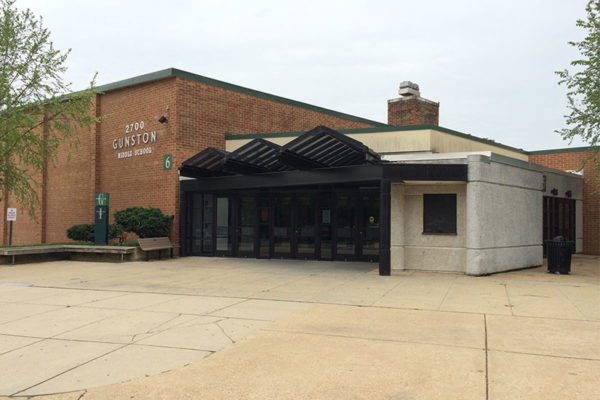
The Arlington School Board is set to consider a $1.6 million contract for safety upgrades to the entrance of Gunston Middle School.
At its meeting on Thursday, Board members will also consider approving a preliminary budget of $2.7 million for three other entrance projects.
In 2020, Arlington voters gave the thumbs up to safety renovations for five schools: Gunston, Thomas Jefferson and Williamsburg middle schools, Taylor Elementary School and Wakefield High School.
Construction at Gunston would start in June and be completed in mid-August before school starts on Aug. 29.
Work includes moving the main school entrance and office closer to S. Lang Street, which will require two science rooms to be relocated. The entrance will feature a vestibule where visitors will check in with office staff.
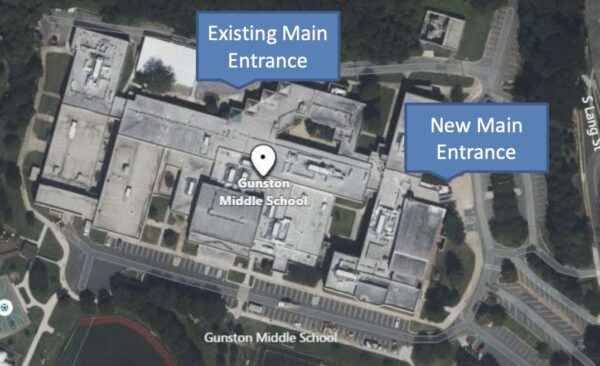
The project scope has also expanded to remediate structural issues related to how the building has settled into the ground over time. APS is budgeting $2.5 million, including contingencies, for the Gunston project and any unspent funds will be used for other capital projects.
This summer, APS will also be making upgrades to Wakefield’s entrance. This project will not have to go out to bid and the school system can move forward without School Board approval.
Design and Construction Director Jeffrey Chambers says the Taylor and Williamsburg projects, meanwhile, have fallen behind. Design work is currently just over halfway complete and staff aim to find a contractor this fall and start work next summer.
“We’re very concerned putting those out to bid or getting pricing or trying to get them constructed this summer because… both from references from our consultants and our experience with regard to projects we’ve recently finished, there are some serious issues still in the supply chain,” he told the School Board last month. “We don’t want to start projects, especially with administrative offices, and not be able to finish them.”
APS staff are recommending that work at Jefferson be deferred until APS is ready to make substantial renovations to the school.
“It was going to require a lot more renovations to that building than what we had budgeted for,” he said. “We felt it was better to defer that to a future, larger project.”
The public schools system is staggering these projects, all part of the adopted FY 2021 Capital Improvement Plan, because “rapid construction price escalation and supply chain delays [have] impacted the anticipated construction cost and completion,” according to the presentation.
APS has made security upgrades to more than half of its school buildings and aims to complete this work “within the next few years,” Chambers said.
Arlington County is receiving $35,000 of assistance to design more “traffic gardens” to help kids learn about traffic safety.
Earlier this week, the National Capital Region Transportation Planning Board (TPB) awarded $250,000 of consulting services to five D.C.-area projects with the intention of improving “safety on the region’s roadways, especially for its underserved communities.”
One of those is a joint project from Arlington County and Prince George’s County to build traffic gardens at schools.
“Traffic gardens are miniature transportation networks with familiar roadway elements, in which children can walk, bike, and scoot to learn the rules of the road and practice their transportation safety skills,” principal planner Christine Baker for Arlington’s Department of Environmental Services writes to ARLnow.
The hope is that this project and the consulting services being granted will help develop universal guidance and templates so that schools can build its own gardens on “any budget” using a number of different materials and equipment.
Arlington has had two recent examples of temporary school-based traffic gardens, one at Key Elementary School in the Bluemont neighborhood and the other at Hoffman-Boston Elementary School in Arlington View. Those schools used common, everyday materials — like spray bottles, measuring sticks, string, and chalk — to construct the roadway.
“We expect that schools will use the guidance to evaluate the traffic garden design possibilities for their own site,” says Baker. “Most schools take advantage of under-used hard surfaces outdoors, like blacktops, courts or other asphalt to create more permanent projects, while those with less capacity can retrofit gymnasiums with tape to create pop-up traffic gardens.”
Baker also notes that young students can take the lessons learned on these mini, safer roads and bring them back to their neighborhood.
“Traffic gardens not only help to educate children on the transportation system now but instill safety habits and transportation values that last a lifetime,” Baker says.
The TPB, which operates under the Metropolitan Washington Council of Governments (MWCOG), will in the coming months be hiring a consultant in the that will be providing working with both counties on the project. It’s unclear at this point when the Arlington schools will have traffic gardens installed.
The initiative fits in with the county’s Vision Zero initiative, a plan to eliminate transportation-related deaths and serious injuries on county streets and trails within the next decade. This includes the recent implementation of “slow zones” near schools.
“Our Vision Zero transportation safety program is not just about engineering safety improvements on our roadways. There is a big emphasis on community engagement and education around safety,” says Baker. “Traffic gardens are an amazing way to educate our community members from a young age to embrace safe transportation practices.”
TPB approved four other projects for funding in nearby jurisdictions, all related to road safety and pedestrian improvements, including in the City of Alexandria, Fairfax County, Prince William County, and the City of Falls Church.
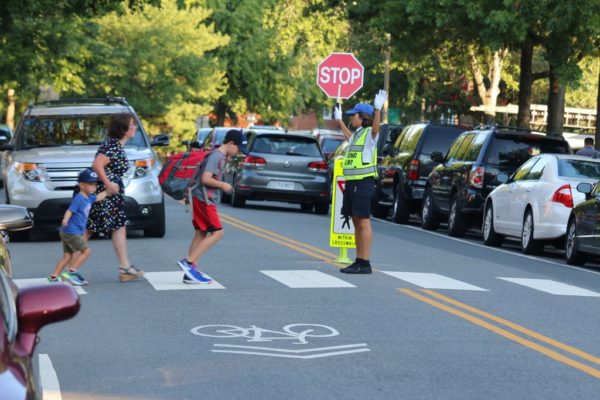
(Updated at 9:35 p.m.) Arlington County is looking to lower speed limits near schools as part of its ambitious Vision Zero initiative to eliminate serious traffic-related injuries and deaths by 2030.
This Saturday, the County Board is set to decide whether to authorize a public hearing next month to discuss and potentially approve creating “slow zones” on residential streets near 13 schools.
The proposed 58 zones, with a speed limit of 20 mph, will be near 11 Arlington public schools and well as Bishop O’Connell High School and St. Thomas More Cathedral School.
“Attempts to reduce or eliminate fatal and critical crashes can be achieved by regulating unsafe speeds on our streets with measures such as signage and pavement markings,” a county report said. “Lowering the speed limit can be a basic and powerful tool for reducing vehicle speeds.”
Traditionally, Arlington has installed flashing beacons to encourage drivers to adhere to reduced speed limits near schools. The report said these signs are inconsistently installed and are costly to maintain, while “static signage” and pavement markings, reminding drivers the speed limit is always 20 mph, are cheaper and easier to install.
The signage and markings will be tested out at these 13 sites before they’re installed across Arlington.
“Slower speeds around schools is a no-brainer, and are beneficial for everyone,” Vision Zero program manager Christine Sherman Baker told the Transportation Commission earlier this month. “We want to prioritize safety in school zones because children are still learning how to travel safely: how to cross the street, how to ride a bike. They’re some of our most vulnerable users.”
And they’re learning these skills in risky areas: according to the report, 10 or more speeding-related crashes annually happen within 600 feet of a school in Arlington.
Some schools were chosen because they’re new or have existing infrastructure in need of upgrades, she said. Hoffman-Boston Elementary, Drew Elementary and Gunston Middle schools were chosen because they’re near high-injury networks — and including them would help meet Vision Zero’s equity component.
This fall, Arlington County Police Department has been collecting speeding data that will be compared with new data collected next spring to see if these zones are effective, she said.
The community can provide feedback in March and April of next year, ahead of the county-wide roll out, she added.
The proposal was met with enthusiasm from Transportation Commission members and some members of the public.
“Bravo,” Transportation Commission Chair Chris Slatt said. “I think it’s fantastic.”
Representing local advocacy group Arlington Families for Safe Streets, Gillian Burgess voiced her support for the program during the meeting.
“Slower speeds around schools are not only great for the safety of vulnerable road users, but it also encourages activity, which addresses both child health and health equity,” she said. “It improves air quality and noise pollution around schools… and it promotes mental health and social inclusion.”
ACPD should also “commit publicly” to enforcing speeding near schools, preferably via speed cameras and not just for speeds 10 mph or more above the limit, while the county should consider closing streets in front of schools to cars, Burgess added.
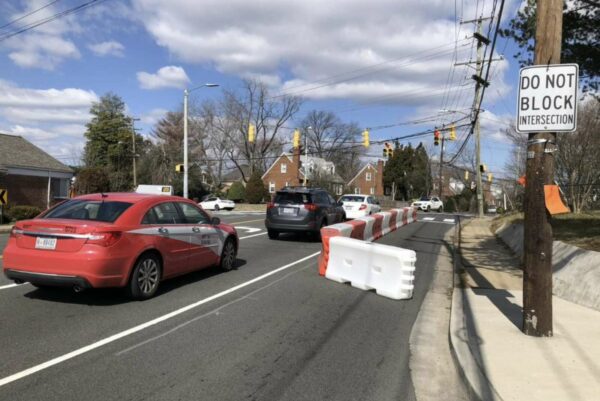
Temporary bollards and wheel stops along a segment of S. Carlin Springs Road are set to come down this weekend.
Since March, these barriers — closing off the northbound right travel lane from 8th Place S. to 5th Road S. — have been up to give more room to kids walking to their neighborhood schools. On Saturday (July 24), S. Carlin Springs Road will fully reopen to traffic, according to a tweet from Arlington’s Department of Environmental Services.
Based on community feedback and field study, the northbound right travel lane of S Carlin Springs Rd from 8th Pl S to 5th Rd S will reopen to traffic this Saturday. The lane had been used for a temporary pilot walkability route. #VsionZero https://t.co/Lj1Zw8i2MH pic.twitter.com/P0UemcJhzf
— Arlington Department of Environmental Services (@ArlingtonDES) July 22, 2021
“APS and the Department of Environmental Services saw an opportunity to create pilot temporary walking routes not on built sidewalks but rather on space carved out from an original travel or parking lane to help students get to school,” DES spokesman Peter Golkin said.
Campbell Elementary School, Glen Forest Elementary School and Carlin Springs Elementary School are all on or near that stretch of S. Carlin Springs Road that starts in Arlington Mill and ends in Glencarlyn.
The pilot walkability route was part of the county’s five-year Vision Zero Action Plan, aimed at eliminating traffic-related deaths and severe injuries. The County Board approved the Vision Zero safety plan this May.
“Staff collected information on facility use feedback, community experience, field observation of operation, traffic pattern, crash experience, etc.,” Golkin said. “Staff hope to use the comments and data to inform future decisions.”
DES and APS will continue studying how the road is used to decide any future changes to traffic patterns, he said. They also tested out the idea on Lorcom Lane in residential North Arlington, which has seen prior attempts to improve safety for kids walking to school.
Although the test was part of a long-range plan, the department took advantage of conditions this spring — when there were fewer cars on the road due to the pandemic and kids were starting to walk to school again — to pilot the change, Golkin noted.
He says neither the Arlington County Police Department nor APS observed a notable increase or decrease in the number of collisions during the study period. Instead, they saw “challenging and dangerous encounters, but none resulted in a collision.”
Northside Social Sued by Songwriters — Clarendon cafe Northside Social is being sued by the American Society of Composers, Authors and Publishers (ASCAP) for “unauthorized public performance of its members’ copyrighted musical works.” [Patch]
Phil Vassar Visits Animal Welfare League — “We had a special visitor at AWLA today: country music singer Phil Vassar stopped by the shelter today to meet three neonatal kittens that are named after his hit songs; Deputy Ray, Carlene, and Amazing Grace.” [Facebook]
Focus on Arlington’s School Resource Officers — The Arlington County Police Department has thirteen School Resource Officers, whose job it is to connect with and protect the 27,000 students at Arlington Public Schools. [WJLA]
Arlington’s First Black Firefighters Faced Hardships — “The first of Arlington County’s black firefighters — members of the Hall’s Hill Volunteer Fire Department and the paid men at Station No. 8 — grappled with taunts and inequities in the days of Jim Crow, according to Arlington Public Library records.” [Arlington Fire Journal]
Dems Want More Social Followers — Arlington Democrats are pushing for more social media followers, particularly on Facebook, with the goal of having the most followers of any Democratic organization in the Commonwealth. At last check, Albemarle County Democrats had more followers than Arlington. [InsideNova]


